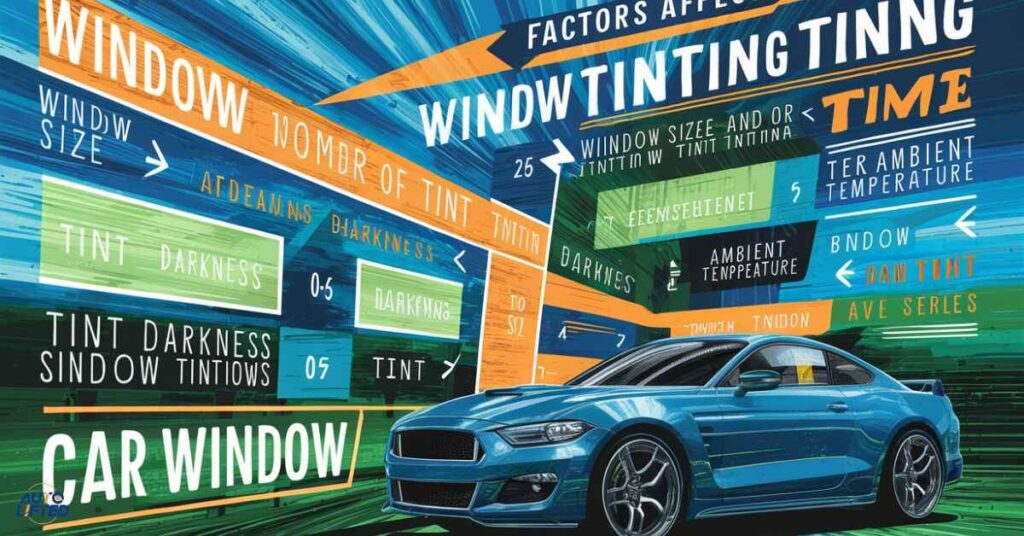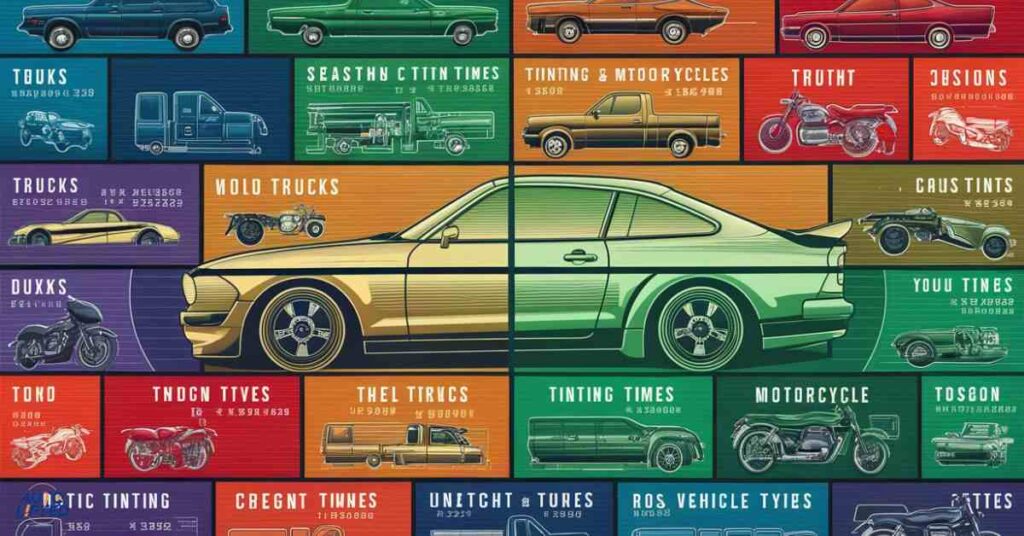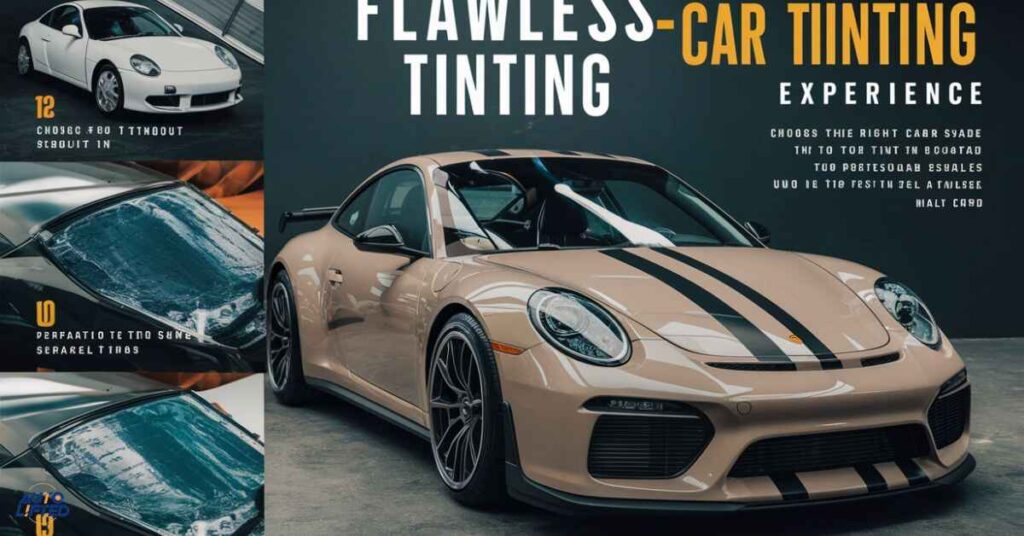without your vehicle for days? Many drivers hesitate to tint their windows due to Does getting your car windows tinted seem like a daunting task that will leave you concerns about the time commitment involved.
However, understanding the typical tinting timeframes and factors that impact the process can help ease those worries.
Let’s be honest, who hasn’t felt that sinking feeling when the summer sun is beating down, causing the interior of your car to become an oven? Or maybe you’ve grown tired of prying eyes being able to gaze directly into your vehicle.
Adding window tint film can provide relief from those issues by blocking up to 99% of UV rays and giving you welcomed privacy. But just how long does it take to actually get the tint installed.
The short answer is: for an average car, tinting all windows professionally usually takes between 1-4 hours. But there’s more to the story than just that general timeframe. Numerous variables can impact whether your tint job falls at the shorter or longer end of that range. This guide will dive into those key factors so you know what to expect for your specific vehicle and tinting needs.
Factors That Affect Car Window Tinting Time

Not all tinting jobs are created equal in terms of how long they take. The total installation time depends on several variables:
Read This Blog:
Why Does Buying A Car Take So Long
Number and Size of Windows Naturally, tinting more windows is going to add to the total time required. An SUV or truck with more glass surface area to cover is going to take longer than a compact sedan. Similarly, larger windows increase the demands versus smaller panes of glass.
For example, tinting just the two front windows on a sedan may only take 30-45 minutes. But doing a full tint on all windows of that same sedan could span 1-2 hours.
Type of Tint Film Used
Another factor is the specific tint film product being installed. Some of the most common options include:
- Dyed tints (most basic, made by applying dye to adhesive film)
- Metallic tints (contain metallic particles to block more heat/UV rays)
- Carbon tints (use carbon particles instead of metal)
- Ceramic tints (non-metallic nanoparticles, blocks over 99% UV)
- Crystalline films (use nano-ceramic particles)
While the differences are subtle, some films are slightly more finicky to work with than others based on their particular characteristics and construction. High-end ceramic options may demand a bit more care and precision from the installer versus basic dyed tint film.
Window Accessibility and Complexity Tinting oddly-shaped or heavily-curved glass can increase difficulty compared to simpler, flat pane installations. Rear windshields are often among the most cumbersome areas due to their raked angles and contours that require extra cutting, heat-molding and squeegeeing by the installer.
Need to Remove Existing Tint If your vehicle currently has old tint film that needs to be removed before new tint is installed, this process adds extra time to the appointment. Removing tint in good condition may only add 30 minutes or so. But if the old film is heavily faded, scratched, bubbly or hardened from years of sun exposure, it could take hours of painstaking labor to strip it all off each window.
Skill and Experience of the Installer
There’s no substitute for practice and experience. A true professional window tint installer working with high-quality tools and materials will be able to work much faster than a DIY amateur tackling their first tinting job. Skill and speed come through repetition over many years and installations.
Average Tinting Times by Vehicle Type

To give you a better idea of what to expect, here are some typical window tinting timeframes based on vehicle size and scope of the job:
| Vehicle/Tinting Job | Estimated Time |
| Sedan – All Windows Tinted | 1-2 hours |
| SUV/Truck – All Windows | 2-4 hours |
| Just Front Two Windows | 30-45 minutes |
| Sunroof or Rear Windshield Only | 30-60 minutes |
These are just general estimates though. Specific circumstances like older tint removal, specialty film types, and levels of window accessibility can cause times to vary outside these ranges.
Why Going Pro Is Faster (And Better)
You may be tempted to try tinting your own windows as a weekend DIY project in the name of saving some money. And there’s no denying that installing tint film isn’t inherently complicated from a process standpoint.
However, doing it properly and efficiently takes skills and tools that professionals have finely honed over years of experience. Not only will they be able to complete the job much faster, but their meticulous techniques help maximize durability and appearance.
I decided to tint my own car to save some cash, but it probably took me 10 hours spread across two days of work. It looks decent from a few feet away, but whenever you really study the windows up close there are lots of small creases, bubbles, and uneven spots from my amateur work. I’ll definitely be paying professionals next time. – Nick R., Portland, OR
On top of spending far less overall time and effort, professional tinting jobs also come with lengthier warranties that save you from potentially having to re-do the work in just a couple years if the tint starts degrading or peeling. When you consider the time savings, better results, and longevity, the extra upfront cost is well worth it.
The Importance of Proper Curing Time

Once the tint film has been successfully installed on your car’s windows, the work still isn’t quite complete yet. There’s an essential “curing” phase that the tint goes through over the next few days and weeks that you need to be aware of.
Immediately after install, the newly-tinted windows will have a hazy, cloudy appearance rather than being perfectly see-through. This is completely normal and expected. It’s caused by the film releasing microscopic water molecules as part of the adhesion process, leaving a temporarily foggy look.
Over time – usually about 3-5 days in warm weather, or potentially several weeks in colder temperatures – that moisture will fully evaporate. As it does so, the tint film will gradually turn from cloudy to perfectly clear and optically unnoticeable (beyond the intended shaded tint coloration of course).
However, it’s critically important not to roll down your windows during those initial days after tinting while the film is curing and adhering to the glass. Any premature rolling can actually cause the tint to peel away, develop bubbles and cracks, turn purple-ish in color, or become loose.
To allow for proper curing and prevent those issues, window tint professionals always advise:
- Don’t roll down windows for at least 2-4 days after install
- Park your vehicle out of direct sunlight if possible
- Use towels or shades to block and reduce the sun exposure hitting the windshield area
With some basic precautions and patience, the film will fully cure and adhere exactly as it’s supposed to without complications. Rush the process though, and all that time and money spent on tinting could be wasted.
Other Factors Impacting Cost and Timeframe
Beyond just the physical installation aspects, there are a few other variables that can influence pricing and how long the full process takes from start to finish:
Location As with most services, tinting costs vary based on local market rates for labor and business operating expenses. Services in major cities or high cost-of-living areas tend to be pricier than smaller towns and rural regions.
Tint Film Quality Not all window tint is created equal. Basic dyed and metallic tints are typically the most affordable option. Prices increase for higher-end films like ceramic, crystalline, and other specialty nanoparticle formulations providing superior heat rejection and UV blocking performance.
Vehicle Age and Complexity Tinting brand new vehicles with sophisticated curved window designs can take more effort than older, squarer car shapes with simpler flat panes of glass. Some installers may need to charge higher rates accordingly.
Shop Demand and Availability Popular, well-reviewed tint shops may get booked up with more appointments than they can handle during peak seasons. This high demand could mean longer wait times before they can slot you in for an installation appointment.
Discounts and Specials On the other hand, many retailers offer promotions, coupons, or bundled pricing on full car tints that can reduce costs compared to individually pricing out each window. It never hurts to ask about any potential deal pricing.
Tips for a Smooth Tinting Experience

To make your window tinting process as easy and stress-free as possible, here are some additional tips to keep in mind:
Do thorough research on tint shops in your area
Don’t just pick the closest or cheapest option. Read reviews from previous customers and compare ratings to find the most reputable tint shops. Look for ones that specialize in automotive window film and have years of experience. A little extra research upfront can save you from subpar work or issues down the road.
Get multiple quotes to compare pricing and timeframes
Tinting costs can vary quite a bit from one provider to the next. Get at least 3 quotes detailing the full scope, materials being used, labor costs, and estimated completion times. That allows you to better judge value and set reasonable expectations.
Also Read This Blog:
What Causes Car Ac Compressor Failure
Make an appointment – no walk-ins Reputable tint shops operate on an appointment-only basis for the most part. This allows them to schedule installers and give each job the proper time and attention it requires. Walking in unannounced will likely just result in being turned away.
Be clear on exactly what you want tinted Specify if you want just the front two windows, all four side windows, the rear windshield, sunroof, etc. Different window combinations impact the overall timeframe, so your installer needs to know upfront.
Ask about warranties and curing period instructions Any quality tint job should come with at least a 1-year warranty against peeling, bubbling, etc. Also get clear aftercare instructions on curing times, when you can roll down windows, and how to properly maintain the tint going forward.
Don’t work the installer while they’re on the job As tempting as it may be to chat with them, constantly interrupting and distracting the tint installer can slow them down and increase the chance of mistakes being made. Let them focus so they can work efficiently.
Leave your car for the day or the wait time quoted For longer full car tints of 2+ hours, it’s best if you can leave your vehicle and run any other errands you need to. This prevents distractions and lets the pros handle the job. For shorter jobs, be prepared to wait or grab a coffee nearby as most shops don’t have lounging areas.
Tip if you’re satisfied with the quality While not mandatory, leaving a 10-15% gratuity for a job well done is always appreciated by the hardworking installers. It helps ensure you get prioritized for any future tinting needs.
Here’s a quick case study highlighting the importance of using a reputable pro rather than cutting corners:
Case Study: DIY Tint Attempt Gone Wrong John, an experienced DIYer from Manchester, decided to tint his own car windows to save some money. He watched a couple YouTube videos and got started applying an inexpensive dyed tint film he ordered online.
The installation went okay on the first three windows. But when he got to the larger rear windshield, he struggled with the curves and ran out of film partway through. The patch job looked terrible.
On top of that, John didn’t leave enough gaps along the edges on the other windows he had fully tinted. Within 3 weeks, moisture trapped inside began causing purpling and bubbling – ruining his work.
In the end, John had to pay a professional $375 to completely remove his amateur tint job and start over from scratch using quality ceramic film. The two-day fiasco and eventual re-do cost far more than just getting it done right the first time by experts.
The moral of the story, While tinting may seem straightforward, it takes real skills and experience to get perfect, long-lasting results. Doing it yourself as a newbie is often False economy compared to the affordable pricing at most professional tint shops.
Frequently Asked Question
How long does it take to tint a car all around?
Tinting a car all around typically takes 2 to 4 hours, depending on the vehicle size and the tinting professional’s experience. Scheduling an appointment in advance can help ensure a quicker process.
Can I roll my windows down 2 days after tint?
It is recommended to wait at least 3 to 5 days before rolling your windows down after tinting to allow the film to fully adhere and cure properly, preventing any damage.
How many years does tint last?
High-quality car window tint can last between 5 to 10 years, depending on factors like the quality of the film installation and exposure to sunlight and weather conditions.
How long does ceramic tint take to dry?
Ceramic tint typically takes about 2 to 4 days to dry completely, though full curing can take up to a few weeks depending on the weather and humidity levels.
Will car tint fade?
Yes, car tint can fade over time due to prolonged exposure to sunlight and UV rays. However, high-quality films, especially ceramic tints, are more resistant to fading.
Does tint get darker as it cures?
No, tint does not get darker as it cures. The tint may appear slightly darker during the initial curing process, but it settles to its final shade once fully cured.
Conclusion
As you can see, there are quite a few variables that impact the total tinting timeframe – from the type of tint film used, to the vehicle’s size and window complexity, all the way down to geographic labor rates. But in general, you can expect:
- 30-45 minutes for just tinting the front two windows
- 1-2 hours for a full tint on an average sedan
- 2-4 hours for an SUV, truck, or van
The installation is just one piece of the puzzle though. Giving the newly-applied window film 2-4 days (warm weather) or up to several weeks (colder temps) to properly cure is absolutely crucial for long-term durability and clarity. Skipping that crucial step can lead to peeling, bubbling, and other deterioration.
While attempting a DIY tint is possible for skilled Weekend Warriors, the faster turnaround, superior quality, and professional warranties provided by an experienced tint shop make it well worth the investment for most drivers. A little patience and going with reputable pros helps ensure you get stellar results you’ll enjoy for years to come.
So do not delay enhancing your vehicle and driving comfort any longer. Line up a window tinting appointment soon to add stylish privacy, UV protection, and coolness to your daily ride.
